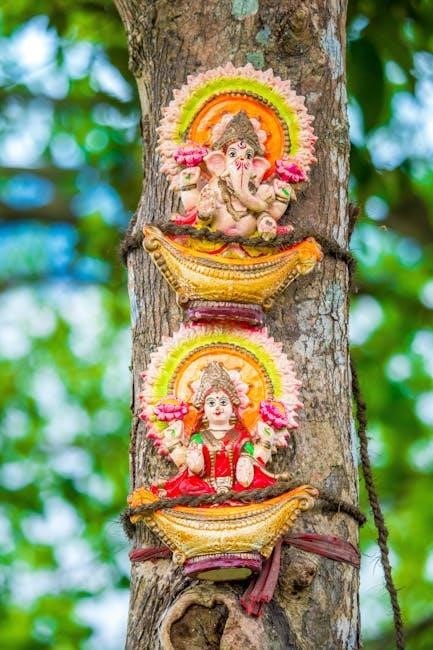Sri Lakshmi Ashtottara Shatanama Stotram is a sacred Hindu hymn comprising 108 divine names of Goddess Lakshmi, symbolizing her eternal grace and prosperity․ Recited for spiritual growth and material abundance, this Stotram is widely revered and easily accessible in Telugu PDF format for devotees worldwide, enhancing its reach and practice in modern times․
1․1․ Overview of the Stotram
Sri Lakshmi Ashtottara Shatanama Stotram is a revered devotional hymn dedicated to Goddess Lakshmi, embodying her 108 sacred names․ This Stotram is a powerful mantra that extols her virtues, seeking her blessings for prosperity and peace․ Composed in Sanskrit, it has been beautifully translated into Telugu, making it accessible to a broader audience․ The hymn is structured as a lyrical tribute, each name highlighting a distinct attribute of Lakshmi, from her divine beauty to her role as the granter of wealth and wisdom․ Its rhythmic and spiritual essence makes it a popular choice for daily recitation and worship rituals, fostering a deeper connection with the divine feminine energy․
1․2; Importance of the 108 Names of Lakshmi
The 108 names of Lakshmi in the Ashtottara Shatanama Stotram hold profound spiritual and cultural significance․ Each name embodies a unique attribute of the goddess, such as her benevolence, wisdom, and prosperity․ Reciting these names is believed to invoke her blessings, bringing harmony and wealth into one’s life․ The number 108 symbolizes completeness and spiritual fulfillment in Hindu tradition․ Devotees consider chanting these names a potent way to connect with Lakshmi’s divine energy, fostering inner peace and material success․ The Telugu PDF version ensures easy accessibility, allowing devotees to recite the Stotram with devotion and correctness, enhancing their spiritual practice․

Structure and Composition of the Stotram
The Stotram is a poetic composition listing 108 names of Lakshmi, each with distinct spiritual significance․ It is written in simple, devotionally rich Telugu, making it accessible for recitation and reflection, while its PDF format ensures easy availability for devotees․
2․1․ The 108 Names and Their Significance
The 108 names of Lakshmi in the Stotram are a sacred enumeration, each representing a unique aspect of her divine attributes․ These names collectively embody her virtues, such as prosperity, wisdom, and compassion, while individually highlighting specific blessings she bestows․ The selection of these names is deeply symbolic, reflecting her role as the embodiment of spiritual and material wealth․ The structure follows traditional Sanskrit poetic meters, ensuring rhythmic recitation and meditative focus․ Each name is a mantra, believed to invoke blessings and protection, making the Stotram a powerful tool for devotion․ The Telugu PDF format preserves these sacred names, ensuring accessibility for modern devotees seeking spiritual growth and harmony․ The names are often chanted in rituals, reinforcing their cultural and religious significance in Hindu worship․ This sacred list not only honors Lakshmi but also serves as a guide for followers to emulate her virtues in their lives․ The 108 names encapsulate the essence of her divine presence, making the Stotram a timeless devotional treasure․ The availability of the PDF enhances its reach, allowing global devotees to connect with her blessings effortlessly․ The names are also interpreted as a path to self-realization, aligning with broader Hindu philosophical themes․ Thus, the 108 names are not just a list but a profound spiritual journey in themselves, deeply cherished in Hindu tradition․
2․2․ Linguistic and Cultural Context

The Sri Lakshmi Ashtottara Shatanama Stotram is deeply rooted in Hindu tradition, with its origins in Sanskrit․ Its translation into Telugu reflects its cultural adaptation, making it accessible to a broader audience in South India․ The Stotram is integral to devotional practices, particularly in Telugu-speaking regions, where it is often recited during festivals like Diwali and Navratri․ The Telugu version maintains the original spiritual essence, ensuring its relevance in modern worship․ The PDF format aligns with contemporary preferences, blending tradition with convenience․ This linguistic adaptation underscores its enduring cultural significance, fostering spiritual connection and continuity across generations․ The Stotram remains a vital part of Hindu heritage, resonating deeply with its audience․
Benefits of Reciting the Stotram
Reciting the Sri Lakshmi Ashtottara Shatanama Stotram brings prosperity, peace, and divine blessings․ It attracts positive energy, enhances spiritual growth, and fulfills material desires, fostering harmony and success in life․
3․1․ Spiritual and Material Benefits
Reciting Sri Lakshmi Ashtottara Shatanama Stotram offers profound spiritual and material benefits․ Spiritually, it strengthens devotion, purifies the soul, and brings inner peace․ Materially, it attracts wealth, prosperity, and success․ Regular recitation is believed to eliminate financial obstacles and grant divine blessings, ensuring a harmonious and fulfilling life․ The hymn’s verses are known to create a positive aura, fostering balance between spiritual growth and worldly comforts․ Devotees often chant it during auspicious occasions to invoke Goddess Lakshmi’s grace, believing it enhances their lives with abundance and happiness․ Its benefits are widely acknowledged, making it a cherished practice among believers․

3․2․ Rituals and Practices Associated with the Stotram
Devotees often perform specific rituals while reciting Sri Lakshmi Ashtottara Shatanama Stotram to enhance its efficacy․ These include offering flowers, lighting lamps, and maintaining a clean altar․ Chanting during early mornings or Fridays is considered auspicious․ Some perform it as part of daily puja, while others recite it during Navratri or Diwali for amplified blessings․ The Stotram is also chanted with offerings like turmeric and vermilion to invoke Goddess Lakshmi’s favor․ Regular practice with sincerity is believed to deepen spiritual connection and yield material prosperity․ These rituals, rooted in tradition, create a sacred atmosphere conducive to divine worship and inner peace․ They are integral to the Stotram’s practice, fostering devotion and harmony in life․
Availability of Sri Lakshmi Ashtottara Shatanama Stotram in Telugu PDF
The Sri Lakshmi Ashtottara Shatanama Stotram in Telugu PDF is readily available on popular websites like stotranidhi․com and other devotional platforms, offering easy access for devotees worldwide․

4․1․ Popular Websites and Platforms Offering the PDF
Several reputable websites provide the Sri Lakshmi Ashtottara Shatanama Stotram in Telugu PDF format․ Stotranidhi․com is a prominent platform offering this document, updated regularly for devotees․ Additionally, websites like [www․telugubhakti․com](http://www․telugubhakti․com) and [www․devotionaltelugu․com](http://www․devotionaltelugu․com) host the PDF, ensuring easy accessibility․ These platforms often feature downloadable options, enabling users to save and recite the Stotram conveniently․ Some sites also offer bilingual versions, combining Telugu text with English translations, catering to a broader audience․ Furthermore, YouTube channels like Lakshmi Hrudaya provide audio versions, complementing the PDF downloads․ These resources collectively make the Stotram widely accessible, fostering devotion and spiritual practice among followers worldwide․
4․2․ How to Download and Use the PDF
To download the Sri Lakshmi Ashtottara Shatanama Stotram in Telugu PDF, visit trusted websites like stotranidhi․com or telugubhakti․com․ Search for the Stotram, click the download link, and save it to your device․ Once downloaded, open the PDF using a reader app․ For optimal use, save it to your phone or print it for easy access during daily prayers․ Recite the names with devotion, ideally during puja or meditation, to enhance spiritual benefits․ Some platforms also offer printable versions, making it convenient for ritual use․ Ensure to download from reliable sources to maintain the authenticity and clarity of the text․

Key Verses and Their Meanings

Key verses in the Stotram highlight Lakshmi’s divine attributes, such as “Mahalakshmi Namostute,” praising her as the remover of obstacles and granter of prosperity․ Each name embodies her benevolent essence․
5․1․ Analysis of Prominent Names of Lakshmi
Prominent names like Mahalakshmi and Kamalvaasini highlight her universal motherhood and divine presence․ Vishnupriya signifies her eternal bond with Lord Vishnu, while Dharmasvarupini embodies righteousness․ Each name reflects her attributes, such as prosperity, wisdom, and protection, inspiring devotion and spiritual growth․ These names are deeply revered, offering insights into her cosmic role and benevolent nature, making the Stotram a rich tapestry of divine praise and philosophical depth;
5․2․ Interpretation of Specific Verses
Specific verses in the Stotram, such as those invoking Lakshmi as Kamalvaasini (lotus-dweller) and Dharmasvarupini (embodiment of righteousness), highlight her divine attributes․ These verses symbolize her connection to purity, prosperity, and moral order․ The name Vishnupriya underscores her sacred bond with Lord Vishnu, while Shreedharini signifies her role as the bearer of wealth and good fortune․ Each verse is a meditation on her divine qualities, reinforcing her role as a protector and benefactor, while inspiring devotees to embody these virtues in their lives․

Cultural and Religious Significance
Sri Lakshmi Ashtottara Shatanama Stotram holds profound cultural and religious significance, often recited in rituals and festivals to invoke Goddess Lakshmi’s blessings for prosperity and harmony, reflecting deep spiritual devotion․
6;1․ Role in Hindu Worship and Festivals
The Sri Lakshmi Ashtottara Shatanama Stotram plays a vital role in Hindu worship, particularly during festivals like Diwali and Navratri, where it is chanted to invoke Goddess Lakshmi’s blessings․ Devotees believe that reciting this Stotram attracts prosperity, peace, and good fortune․ It is often incorporated into daily puja rituals, fostering a deep connection with the divine․ The Telugu PDF version of the Stotram has made it accessible to a broader audience, ensuring its traditional significance endures in modern times․ Its melodious verses and sacred meanings resonate deeply, enriching both individual and communal spiritual practices across various cultural contexts․
6․2․ Influence on Devotional Music and Art
The Sri Lakshmi Ashtottara Shatanama Stotram has profoundly influenced devotional music, inspiring numerous compositions and bhajans․ Its rhythmic verses and sacred meanings make it a popular choice for musical renditions, fostering emotional connection and spiritual elevation․ In art, the Stotram’s themes are often depicted in paintings and sculptures, highlighting Goddess Lakshmi’s grace and prosperity․ The Telugu PDF version has further amplified its reach, inspiring contemporary artists to create works reflecting its divine essence․ This timeless Stotram continues to be a source of inspiration, blending music and art to celebrate the divine feminine and her enduring significance in Hindu culture and spirituality․
Sri Lakshmi Ashtottara Shatanama Stotram is a revered devotional text, offering profound spiritual and material benefits to its reciters․ Its availability in Telugu PDF has made it easily accessible, ensuring its timeless appeal․ The Stotram’s 108 names of Lakshmi encapsulate her divine attributes, fostering devotion and prosperity․ Its influence extends beyond worship, inspiring music, art, and cultural practices․ As a sacred hymn, it continues to guide seekers on their spiritual journey, reinforcing faith and connecting devotees with the divine․ Its enduring relevance in modern times underscores its significance in Hindu tradition, making it a cherished resource for spiritual growth and daily worship․